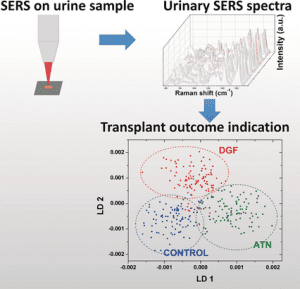The total number of candidates on the waiting list for kidney transplants has increased steadily from approximately 58 000 in 2004 to 99 306 at the end of October 2016. There are two types of donors for kidney transplants, living donors and deceased donors. Unfortunately, demand for kidney transplants still outstrips the supply, and over 5 000 people die every year while waiting on a kidney transplant.
Despite the urgent demand for more kidney donors, a large percentage of kidneys from deceased donors are not used for transplant, especially when donors have a terminal creatinine concentration above 1.5 mg dL–1. Elevated terminal creatinine is a sign of acute kidney injury (AKI), which can be associated with poor transplant outcomes. But several studies showed that this association might not always be correct. A team of the Stevens Institute of Technology in Hoboken, USA, used a SERS (surfacer-enhanced Raman scattering) technique to test new ways of predicting kidney transplant outcomes so that more of the available kidney donors can be used in the future.

Scheme of SERS analysis of urine samples from deceased donors for kidney transplant outcome indication.
SERS is a powerful, label-free analytical technique with excellent sensitivity and molecular specificity. It is a type of Raman scattering spectroscopy that is conducted with the aid of noble metal (typically Ag and Au) nanostructures. In the study, thirty urine samples of donors were analyzed by using SERS. The ATN class consisted of donors whose kidneys had acute tubular necrosis (ATN), the most common type of acute kidney injury (AKI) with high risk of poor graft performance in recipients, yet yielded acceptable transplant outcome. The DGF class was comprised of donors whose kidney had delayed graft function (DGF) in recipients.
The results show a very promising classification ability of the classes by using this technique, especially for the ATN class, of which the sensitivity is ≥90 % in both binary classification and multi-class classifications.
“The ability to differentiate the ATN class from the DGF class is especially valuable, since the kidneys of ATN class are the ones that can be saved and utilized, while the kidneys in DGF class are the ones that have poor performance and should have been discarded”, explains team member Henry Du. This approach has the potential to be transformed into a highly sensitive and specific point of care prognostic tool for quality selection of kidneys from deceased donors, which can help clinicians to expand the kidney donor pool.
Read more on this study and others in the latest issue of Journal of Biophotonics.

















